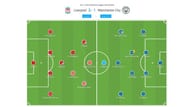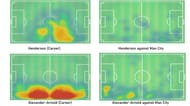A game touted to be the title decider in the Premier League held everyone’s breath in a weekend full of spectacular matches around the globe. Der Klassiker on Saturday saw Bayern Munich thump Borussia Dortmund at the Allianz Arena, Juventus edged out AC Milan 1-0 in a hard-fought tie, Olympique de Marseille beat their bitter rivals Olympique Lyon in Choc des Olympics.
Yet, amidst all the mouth-watering clashes, a potential early-season title decider between Liverpool and Machester City stole the show. Pep Guardiola and Jürgen Klopp fought a tightly-contested tactical battle and both managers looked to counter the other's change in tactics as Klopp prevailed in the ‘Battle of Geniuses’.
On that note, let’s look at the in-depth analysis and where exactly the game was won or lost between the two sides.
Lineups
Klopp started with his tried and tested 4-3-3 formation and Liverpool's lineup didn't spring any surprises. Alisson Becker manned the goal-post, Trent Alexander-Arnold and Andy Robertson assumed their usual positions either side of Virgil van Dijk and Dejan Lovren, who started in the heart of the defence in Joel Matip's absence. Jordan Henderson, Fabinho and Gerginio Wijnaldum provided the extra layer of protection in the midfield and the attacking triumvirate of Mohamed Salah, Roberto Firmino, and Sadio Mané completed the lineup for the Reds.

Guardiola came out with a different formation from the very start. The Spaniard opted to ditch his preferred 4-3-3 in favour of the 4-4-1-1, with Kevin De Bruyne just behind Sergio Agüero, who lead the line as usual. İlkay Gündoğan and Rodri were stationed in the heart of the midfield, with Raheem Sterling and Bernando Silva either side of them to provide the width. the double pivot and tried to contain the attacks from the centre.
With Benjamin Mendy and Oleksandr Zinchenko out injured, Angeliño started at left-back and Kyle Walker was preferred to Joao Cancelo at right-back, as the Cityzens were vary of Liverpool counter-attacking threat.
Due to their on-going defensive crisis, Fernandinho partnered John Stones at centre half and Claudio Bravo replaced the injured Ederson between the sticks, as the Brazilian shot-stopper had picked up a minor injury in their Champions League encounter midweek.
Klopp and Pep’s change in tactics
Both Klopp and Pep adopt a 2-5-3 formation when they attack. Though the formation is the same, their attacking style is different. Klopp uses the wingers to occupy the half-spaces between the defenders and urges his full-backs to provide width in the final third and produce a flurry of crosses.
Although Guardiola instructs his side to deploy a similar formation in attack, wingers provide the width and his midfielders are instructed to occupy the half-space between the opposition defenders. To leave no space in the midfield, the Spaniard usually instructs his full-backs to invert in the midfield region.
In this fixture, however, the former Barcelona man opted to tweak his tactics to a certain degree as he used De Bruyne as a second striker. In recent seasons, teams have deployed similar set-ups against Liverpool and have achieved positive results. With the full-backs high up in the final third, Liverpool have faced difficulty during transition and teams often try to catch them off guard by isolating their centre-backs in 1 v 1 situations.
Klopp was well aware of this and against a potent Manchester City attack, he didn’t want to take that risk. He made tactical adjustments and instructed Alexander-Arnold to stay back, virtually as an auxiliary centre half, and the Reds kept their usual shape of 2-3-5 during attacks.
Robertson was allowed to make his daunting runs through the wings but a major difference was Henderson role, as the Liverpool captain provided width in the final third instead of Alexander-Arnold.
Henderson and Alexander-Arnold’s positional adjustment is also visible from their heat maps where the former occupied more advanced positions and Alexander-Arnold, the exact opposite.

Salah’s Modified Role
Manchester City tried to block the passing lane to their defensive third by playing a double pivot in the form of Gündoğan and Rodri, which prompted Salah to drop deep and play one-touch passes and move the ball forward.
Although Salah was man-marked by Angeliño, the Egyptian dropped deep and pulled Angeliño along with him, which created room to be exploited in the defensive third of the away side's. Henderson occupied the space left by Spanish full-back and Alexander-Arnold often played long balls to the skipper, which left the Cityzens defending 3 v 3 situations.
The youngster also played long balls to Salah, who played first-time passes with the midfielders and moved the ball forward, which left Guardiola's side in a 3 vs 3 situations once again. Out of the 58 passes Alexander-Arnold played in the match, 20 were to Salah, Henderson and Robertson, a startling example of his passing range.

A game of crosses
Klopp and Guardiola shape up their formation to put crosses in the box by overloading it with bodies. Kevin De Bruyne does this time and again for Manchester City and the attacking full-backs, Robertson and Alexander-Arnold do so for Liverpool.
It is no surprise that Liverpool and Manchester City lead the chart in the Premier League when it comes to crosses. The Cityzens, on an average, have delivered 23.81 crosses per game and Liverpool are just behind, with their tally of 20.78.
This game was nothing different, with Man City producing 24 crosses while Liverpool’s number lowered to 14, an anomaly that can be explained by Alexander-Arnold's change of position as explained above.
The second goal Liverpool scored was fascinating to watch and it came through combination play of both the full-backs. Alexander-Arnold played a diagonal ball to Robertson, who was making a run into the opposition half. The Scotsman found Salah inside the box with an inch-perfect cross, who headed the ball in first time past the despairing dive of Bravo.
Henderson was instructed to push up and Alexander-Arnold was ordered to be more defensive. It was the reason Alexander-Arnold provided just three crosses, that too from deeper areas, whereas his season average is 6.6 per90 minutes. Henderson, on the other hand, provided six crosses in the box with his average being just 2.99 per90 mins.
The third goal Liverpool scored, just after the second half was due to a delicious cross by Henderson to Mané.
Wijnaldum and Fabinho – ‘Kings’ in the middle of the park
Guardiola after the match said,” They are strong in set-pieces when you sit back and defend in the box, they open up with Robertson and Alexander with crosses, then they arrive with Wijnaldum, the second balls, it’s almost impossible to live with the second balls.”
This speaks volumes about the midfield duo. They latched onto every second ball that came their way and did everything within their powers to disrupt Manchester City’s counter-attacks.
Wijnaldum was brilliant and was the most effective player on the pitch. He dictated the play, completing 33 of the 34 passes attempted, with an accuracy of 97%. He won five out of the six defensive duels he came up against and also made five interceptions and recovered the ball eight times.
Second-half reshuffle
Henderson started to run out of steam in the second half and left too much space in the right-wing, which left Alexander-Arnold isolated against Sterling. The pair contested seven duals and the Manchester City winger came out on top on five occasions.
James Milner was introduced in favour of Henderson and Klopp opted to deploy a 4-4-2 formation since the former Manchester City man's introduction, as he occupied the left flank with Mane stationed on the left.
Analysing the space left by Mané, Guardiola ordered Angeliño to overlap Sterling and the Englishman occupied the half-space between Alexander-Arnold and Lovren. Added to the fact that seven of his nine crosses came in the twenty-two minutes he was asked to overlap, the Spaniard provided the assist for Bernardo Silva's goal.
Klopp was agitated since he sensed a flaw in his system and wanted to sub in Alex Oxlade-Chamberlain when the ball had gone out of play. The referee did not allow him to do so and just after the throw-in, Man City scored the goal.
Chamberlain’s substitution blocked Angeliño’s daunting runs since he often dropped deep to form a three-man defence and Pep asked his left-back to revert to the usual set-up, where he occupied the inverted midfield position.
Unable to create any chances Pep again went back with Angeliño’s overlapping runs. He again produced two crosses inside the box which prompted Klopp to sub in Joe Gomez for Firmino and resorted to a 4-5-1 set-up.

The last twenty minutes of the second half was all about Pep exploiting the gaps in the left-flank and Klopp trying to preserve his two-goal lead, which he managed to do so effectively.
Tactical battle marred by controversy
The game was managed by two geniuses off the field who constantly played with their tactics to unsettle the opposition. Manchester United vs Liverpool was touted to be the tactical battle of the season but this fixture has overshadowed it by a long distance.
Amidst the tactical battle, this fixture was marred by a hand-ball controversy where Pep Guardiola thought he deserved penalties for two hand-balls by Alexander-Arnold in the box.
Also check out:Premier League Premier League Table UCL schedule